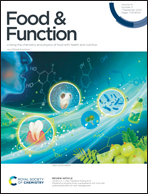A bovine milk-derived peptide ameliorates pancreatic β-cell dedifferentiation through PI3K/Akt/FOXO1 signaling in type 2 diabetes†
Abstract
The lacto-ghrestatin derived nonapeptide (LGP9), a bioactive peptide derived from lacto-ghrestatin in bovine milk with the sequence of LIVTQTMKG, was investigated to determine its effects on islet β-cell dedifferentiation and associated mechanisms in type 2 diabetes mellitus (T2DM). On the animal level, type-2-diabetic (T2D) mice were generated by high-fat-diet (HFD) and streptozocin (STZ). LGP9 was given to T2D mice for four weeks at doses of 1 mg kg−1, 3 mg kg−1, and 9 mg kg−1. A variety of techniques (immunohistochemistry, western blot, QPCR, and ELISA) were employed to evaluate the impact of LGP9 on the diabetic injury. On the cellular level, the pancreatic cell lines, Rin-m5f cells and Min6 cells, were treated with high-glucose (HG) and high-glucose-high-lipid (HG/PA), respectively. The cell models were established to investigate the mechanism of LGP9 treatment on the islet β-cell dedifferentiation. For the mechanism study, the PI3K/Akt/FOXO1 pathway was investigated by inhibiting FOXO1 with its inhibitor and siRNA. Results showed that LGP9 improved the β-cell dedifferentiation, prevented the EMT process, and upregulated the PI3K/Akt/FOXO1 signaling in the pancreas of T2D mice. In addition, LGP9 promoted the structural and functional recovery of pancreatic islets and shielded the liver tissue in T2D mice. From the cellular level data, LGP9 prevented β-cell dedifferentiation and EMT occurrence. To a certain extent, the inhibition of FOXO1 restored PI3K/Akt/FOXO1 pathway activation and prevented β-cell dedifferentiation. In conclusion, these findings suggest that LGP9 ameliorated pancreatic β-cell dedifferentiation via PI3k/Akt/FOXO1 signaling in vivo and in vitro.



 Please wait while we load your content...
Please wait while we load your content...